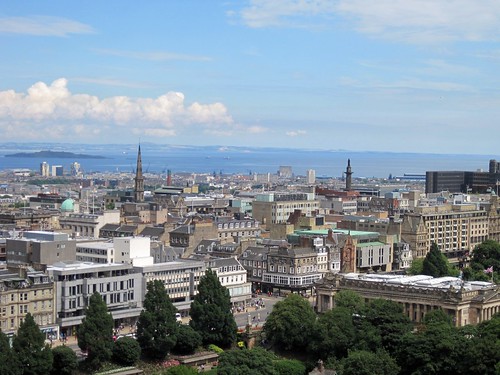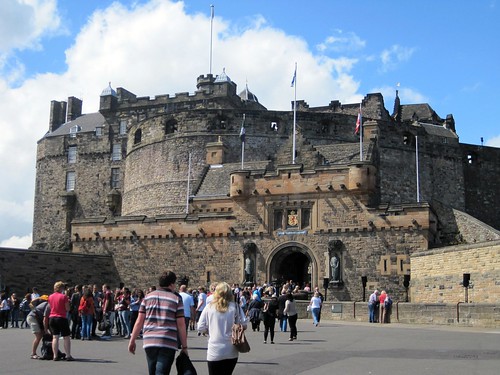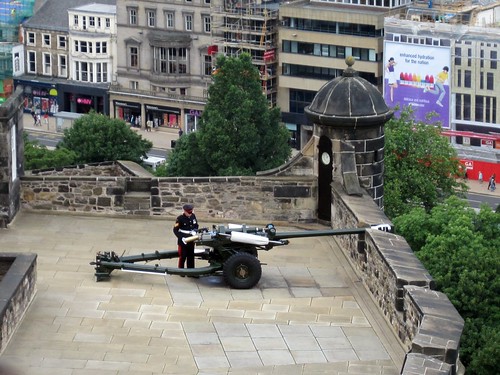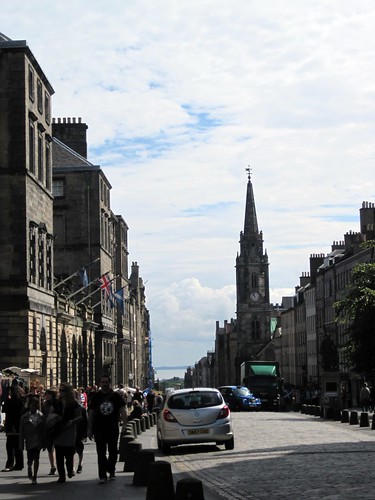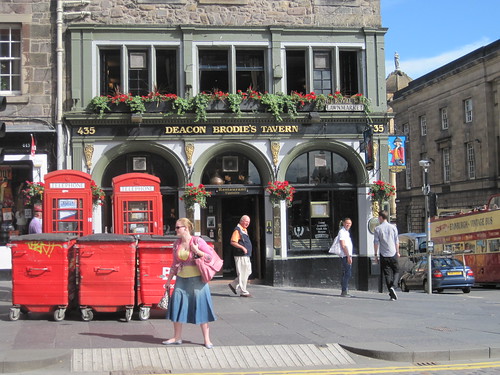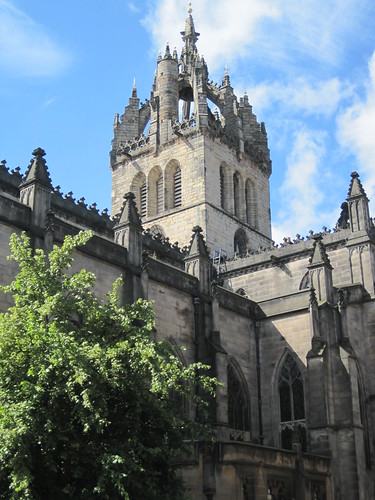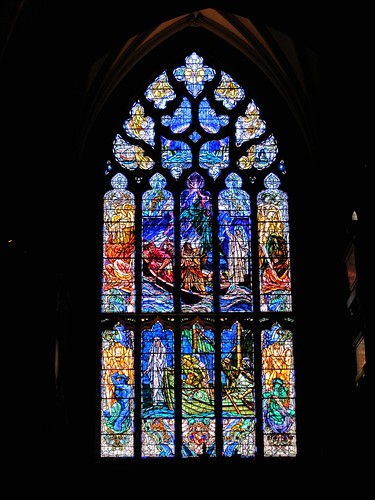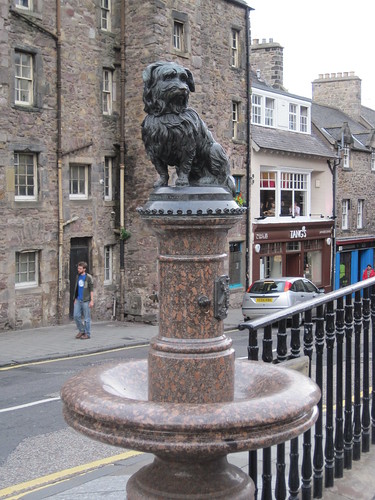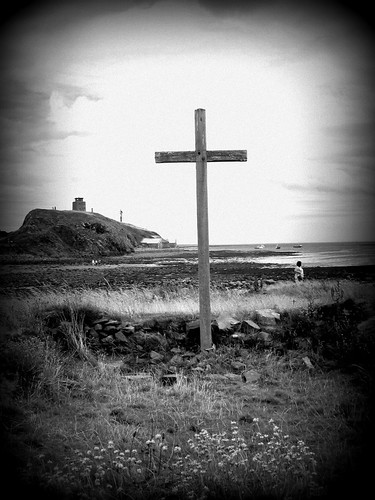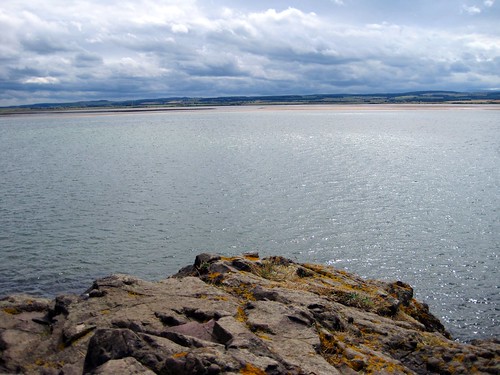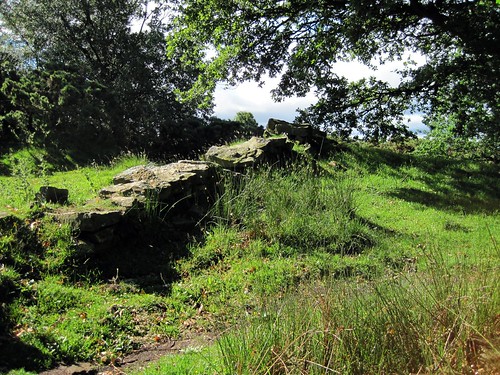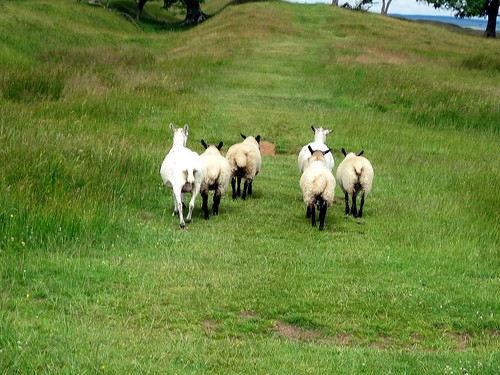The musings, cultural experiences, photos, trials, and tribulations of an American grad student studying medieval history, traveling as much as a grad student budget allows, and drinking lots of tea in the process.
Monday, August 23, 2010
The Firth of Forth and Unplanned Detour with Suprising Results #1
Heading north from Edinburgh, you quickly come to the crossing for the Firth of Forth, an estuary of the River Forth. The Firth of Forth is a fjord carved out by glacier activity during an Ice Age, and is kind of fun to say five times fast. Confession: I've renamed Colin Firth in my head. His new name is Colin Firth-of-Forth. Ok, I should stop rambling. Just over the Firth we came across the first of several intriguing signs that prompted us to detour from our planned route. As you can see by the irksome railing, it's difficult to get good pictures of the Firth from the bridge. But just past the bridge, there was a road marked "Coastal Scenic Route." So we figured, what the heck? Let's go see the coast!
Problem: The Coastal Scenic Route, while plenty scenic, does not actually run past the coast, at least not in the half hour we drove down it. But, a hidden surprise totally made it worth while...
The Tuilyies standing stones consist of one large stone almost 8' tall, and a cluster of three smaller ones. Local lore holds that the group are located on the site of an ancient battle and mark the burial sites of chiefs who died in the fighting. The name Tuilyies itself is thought to be a corruption of the word "tulzie," meaning a fight or battle. There's no advance warning- no signs proclaiming "pull over here cuz there's going to be awesome standing stones in 30 seconds!" so we drove past, gasped, and turned around. The stones are located on private property, and barbed wire is up to discourage people from wandering on the grounds, so one has to content themselves with photos taken from a ways away, unless you're prepared to hop barbed wire and trespass where you are clearly unwelcome. Your choice.
And hey look- you can almost see the water! There's also some really adorable little villages along the route, so while the lack of coast was somewhat disappointing, the little detour certainly was not.
Saturday, August 21, 2010
Edinburgh
Behold, Edinburgh, Scotland's capital (and seat of the Scottish Parliament) and second-largest city behind Glasgow. Edinburgh lies in the southeastern part of Scotland along the Firth of Forth, which provides access to the North Sea. Our stay in Edinburgh was brief (dinner & a haunted graveyard tour and then the morning the next day), so we were limited in what we had time to do. The main districts in central Edinburgh are Old Town and New Town, both of which have been designated UNESCO World Heritage Sites by the way. We concentrated on Old Town, which includes Edinburgh Castle, the Royal Mile-- a high street shopping mecca for all things touristy or plaid (speaking of which, didya know using "plaid" to refer to a checked cloth is an American thing? I didn't.)-- St Giles Cathedral, and Holyrood Abbey/Holyroodhouse.
One of the first things you might notice approaching Edinburgh is Arthur's Seat pictured above. The hills here are the remnants of a long-extinct volcano, eroded by glacier activity long ago. The crag upon which Edinburgh Castle is located is another extinct volcano. There are good hiking trails if you want to climb to the peak of Arthur's Seat, or so I've heard, but alas we didn't have time to go check them out. There are a number of ancient hill forts nestled in the crags, including several thought to belong to the Votadini, who are recorded as one of the British tribes north of Hadrian's Wall during the Roman period. Add a few centuries of language change, and they were known as the Gododdin, who ultimately were defeated by the Angles as recorded in a poem from around 600 AD called Y Gododdin.
Speaking of Edinburgh Castle, ta da! Edinburgh Castle is built high on an imposing crag, dominating the city skyline. The site, chosen for obvious defensive features, has been inhabited for almost three thousand years, with the castle dating to at least the 1100s. This was the royal residence for the kings of Scotland until 1603, when the kingdoms of Scotland and England were united under one king, James VI of Scotland, who inherited the throne of England from Elizabeth I, thus becoming James I of England as well.
If you visit, be sure to be there before 1 pm to get a good spot to watch "Shannon the Cannon," a District Gunner with the 105th Regiment Royal Artillery, fire the One O'Clock Gun, a time signal originally used to notify ships in the Firth of Forth of the time. While most people crowd around the gun itself, you can get better views from the level above, outside St Margaret's Chapel. You'll want to scope out a spot about half an hour before hand, or befriend someone who did and get them to take pictures for you. I just went with awkward reaching around the heads of people in front of me.
The shopping thoroughfare leading up to the Castle is known as the Royal Mile. Here you can find all kinds of tartan, scarves, kilts, postcards, pipes, tobacco, etc etc etc. But from my not-so-extensive travels of Scotland, I'll just mention that you can find better deals on the same items outside of Edinburgh- Stirling has plenty of nice shops priced a bit cheaper, and if you're making a stop in Inverness up north, there are a few nice shops there with slightly better prices.You'll also probably find that prices are a bit better off the Royal Mile, which charges a premium as the center of tourist traffic. The one caveat to that statement, is Deacon Brodie's.
Ok, yes, this is just a pub. Not so exciting you say. Well, sure, but it is absolutely adorable from the outside and on the inside, and has really good food for reasonable prices, especially for along the Royal Mile. During the lunch rush, they can take awhile to get your food prepared, but as long as you aren't in a rush, it is a great place to grab lunch or dinner. And conveniently located across the street from St Giles' Cathedral.
St Giles' is a lovely early Gothic building, with some lovely (but relatively young) stained glass. There has been a church on the site since the early Middle Ages, but the cathedral as it stands now was originally built in 1120s; at this point, it was likely relatively small, and would have been Norman (Romanesque if you're continental) in style. At some point it was rebuilt and expanded; this larger early Gothic building suffered damage from a fire in 1385 and was repaired and expanded into the building you see today.
Now, I've bemoaned the fact that most cathedrals do not allow photography inside on several occasions now. But here, I have nothing but praise. St Giles' does not charge admission to visit, but they do ask for a 2 pound donation if you want to take pictures. Totally reasonable, right? I don't know why more churches don't adopt this idea. Fantastic.
To wrap up Edinburgh, I figured I'd finish with a cute story. Here you see Greyfriars Bobby, a little Skye Terrier devoted to his owner. Now, there's several different stories, but the general story line goes that Bobby belonged to a member of the Edinburgh City Police (in some accounts, he was a watchmen for the Greyfriar Kirk, hence Greyfriar and a "bobby" in the UK is slang for a policeman) in the 1850s. Anyway, the dog's owner passed away, and for the next 14 years, Bobby guarded his master's grave until his own death. Sweet, right? Sadly, most of the story is embellished fiction, the creation of an American author who heard the story from a friend who had traveled to Scotland and heard the story there. And like any good game of telephone, much gets lost along the way. In actuality, it is most likely that the dog, who may have even just been a stray, stayed by the grave because a restaurant just outside the graveyard used to toss scraps over the gate into the cemetery. That, coupled with a stone bench thing just next to the grave in question, meant the dog had steady access to food and shelter. Ah well.
There's more photos from Edinburgh Castle, St Giles', and from a haunted cemetery tour we went on through Greyfriar's Graveyard up on flickr if you're interested. Until next time~
Saturday, August 14, 2010
Holy Island & Lindisfarne Priory
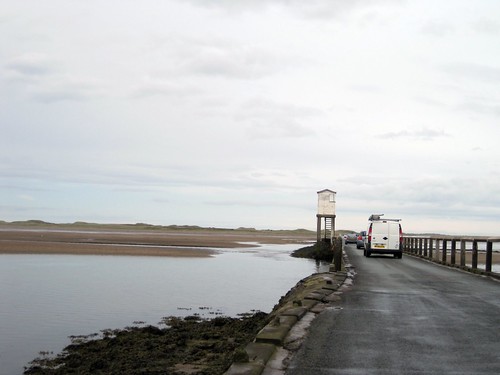
Way up off the coast of northern England just shy of the Scottish border is a special place called Holy Island. It is only accessible from the mainland during low tide, when the North Sea recedes enough to expose the Lindisfarne Causeway and allow cars and hikers to pass. The white box on stilts is actually there as a water shelter in the event that anyone gets stuck in the middle of the causeway as the tide comes in. I think this is mostly a concern for hikers in the event that they underestimate how long it will take them to cross the causeway as the tide comes in. And btw, there's no coast guard to come rescue you; you stay put until the tide goes out again.
A little over 150 people make their home on the island in one village, mostly employed in the tourist trade/hospitality. The island is known as a spiritual retreat, but its main tourist draws are Lindisfarne Priory and Lindisfarne Castle.

The castle was built in the 16th century (so quite late) and served largely as a fort in an area long held in contention between the Scots, the English and earlier, the Vikings. The modern castle was largely remodeled in the early 1900s to serve as basically a grand country manor. It is located on the highest point of the island, about a mile away from the village/priory, but a bus service runs every quarter hour between the two if you don't feel like making the hike.
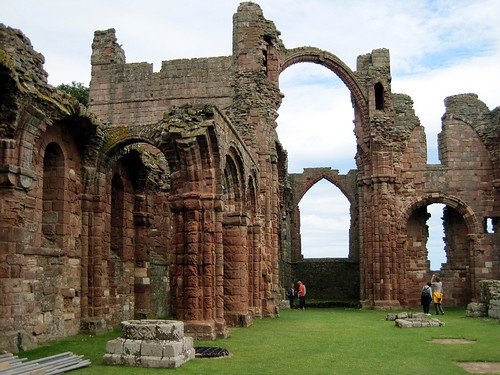
But the real draw, I think, is Lindisfarne Priory. Lindisfarne is one of the oldest Christian establishments in England, founded around 635 by St Aiden, an Irish missionary monk from Iona (a monastery in Scotland also established by Irish missionaries) who established a community on the remote island, which became the center of conversion for northern England. In the 700s, Lindisfarne was a flourishing text-production centre, producing high quality manuscripts, the most famous of which is the Lindisfarne Gospels, now on display in the British Library.
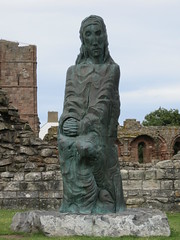 St Cuthbert, perhaps the most famous of the medieval English saints, was a monk, abbot and bishop (not at the same time!) of Lindisfarne, but his relics are now resting in Durham Cathedral as a result of the community of monks fleeing the island in the wake of a Viking attack in 875. An earlier Viking attack in 793 was the first major Viking raid in England and caused quite a bit of consternation and fear among contemporaries, even on the Continent. Monasteries were an attractive target for the Vikings because the monks generally couldn't put up much of a fight, and the monasteries were rich with treasures- golden chalices, rich tapestries, various jewel-encrusted treasures, etc. And in the days before banks, wealthy lay people often entrusted their wealth to the religious houses for safekeeping.
St Cuthbert, perhaps the most famous of the medieval English saints, was a monk, abbot and bishop (not at the same time!) of Lindisfarne, but his relics are now resting in Durham Cathedral as a result of the community of monks fleeing the island in the wake of a Viking attack in 875. An earlier Viking attack in 793 was the first major Viking raid in England and caused quite a bit of consternation and fear among contemporaries, even on the Continent. Monasteries were an attractive target for the Vikings because the monks generally couldn't put up much of a fight, and the monasteries were rich with treasures- golden chalices, rich tapestries, various jewel-encrusted treasures, etc. And in the days before banks, wealthy lay people often entrusted their wealth to the religious houses for safekeeping. So speaking of Vikings, after 805, the monastery was basically abandoned, since the community had fled with Cuthbert's relics and eventually settled in Durham. After the Norman Conquest, religious life was reintroduced to the island and a priory under the authority of Durham was founded. The ruins you see today date to this period of religious life. The priory also has a fantastic visitors centre display, well worth checking out before you make your way out to the priory itself.
But I think my favorite part when I visited was St Cuthbert's Isle. Now, you have to time it right to actually be able to get to it. St Cuthbert's is located just off the shore of Holy Isle and is only reachable during the very lowest part of low tide, but we lucked out. You have to bounce from rock to rock, trying to avoid the large puddles left by the receding sea, and you'll probably end up crushing a fair few shell-dwellers clinging to the rocks in the process (oops), but so worth it.
Cuthbert's Isle is little more than a big rocky outcrop marked with the above simple wooden cross. It is thought that this is one of the small islands near Lindisfarne that Cuthbert retreated to in order to live as a hermit before he was dragged back to become Bishop of Lindisfarne. And I can honestly say there is something incredibly powerful about the place. On a clear day like we had, there is just rocks and sea and sky blending together with the mainland far off in the distance and the wind whistling across the sea. Perfect for meditation and contemplation.
You can do the major tourist sights in a day or a very busy afternoon, but the next time I go back (and there will be a next time by golly!), I'd try to stay at least one night to really have time to enjoy the quiet and solitude and the natural beauty which drew the early Christians to Lindisfarne in the first place.
Labels:
castles,
Epic Roadtrip of Awesomeness,
monasteries,
Trips
Wednesday, August 11, 2010
Hadrian's Wall Country, Part 1: The Approach from Newcastle upon Tyne
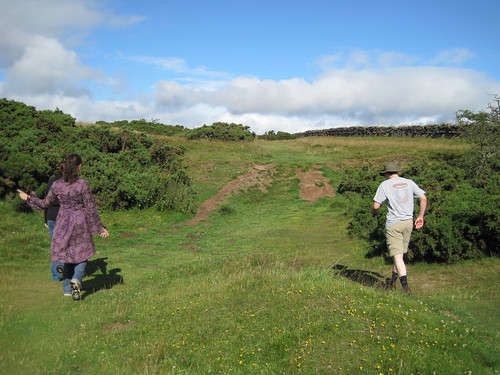
I'm finally (finally!) starting in on what I'm going to call the Epic Roadtrip of Awesomeness, July 2010. Five days, 4 grad students, 1 rental car, 3 tanks of petrol, some # of miles I didn't think to check before we returned the car, 1 big ole road atlas that became my near-constant companion, 3 memory cards full of pictures, and sadly no fried Twinkies or Mars Bars. There was haggis though!
Our first stop on the Epic Roadtrip of Awesomeness was a short hike along Hadrian's Wall Path, an 84-mile long National Trail that runs along- what else?- Hadrian's Wall. If you're interested in a brief overview of the wall, check out my Illuminating Hadrian's Wall entry (you can get to it from the Hadrian's Wall label off to the right sidebar.) We drove up from York and then detoured over from Newcastle towards Hadrian's Wall Country, found a place to pull over, and went for a hike.
There's not really a whole lot of wall standing in this section of the trail, but you can follow the marked path along where the wall once ran. The less ancient stone fencing running through here is likely built from the stones of the wall. We lucked out and had gorgeous weather; it was supposed to just rain rain rain all week, but aside from a few fairly quick showers, all while we were driving, and a miserably wet and muddy field when we got to Culloden, the whole trip was surprisingly dry.
Even though there wasn't a fun wall to climb around on, we still got a welcome chance to stretch our legs and enjoy some scenery. We would have had to drive further out of our way to hit a section of wall still standing, so we decided to just enjoy what we had. The trail is easy to walk and well marked, although you may have to get up close and personal with some sheep.
There's more photos up on flickr if you feel the need for some more idyllic English countryside. But we were particularly excited about this:
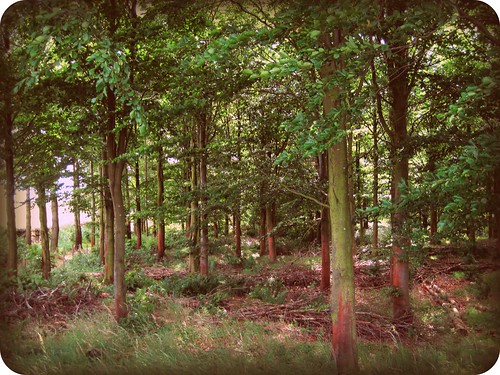
Trees! Most of Yorkshire is either moorland or gently rolling hills covered in crop fields. The presence of trees all closely packed together was kind of exciting and necessitated some frolicking :) Anyway, we hiked westward from almost the eastern-most end of the trail; there will be shots featuring actual wall from the western end of the wall coming from Carlisle to wrap up the Epic Roadtrip of Awesomeness series of posts, so I guess look for that in about 10 entries or so! Till next time~!
Labels:
Epic Roadtrip of Awesomeness,
Hadrian's Wall,
Romans,
Trips
Monday, August 9, 2010
Selby Abbey


Selby was founded in 1069 and clearly reflects its Norman heritage; the chevrons over the main entrance are classic Norman architectural features, as are the engraved columns, which are similar to ones found at Durham Cathedral. Selby also has a few little oddities that set it apart. The picture just above is looking through the Leper's View- this is actually a 17-foot passage through the walls of the church which allows someone standing on the outside to look in to the sanctuary. Legend goes this was so lepers & other undesirables you wouldn't want parading around your church could still participate in worship. This is unusual, because most of the time these leper portals actually just allowed someone in a side chapel to peak at the main altar, but this one legit goes outside. Whether it was ever used by any lepers is unknown.
This is actually looking inside the carved capitol of a column adorning an outer wall of the church. I forget who this was supposed to be, but it is one of the more bizarre things I've seen in a church. You have to use the provided torch (US: flashlight) to even see he's there at all.
This came as a surprise to us Americans. Who knew there was an American Heritage Trail in the UK? Apparently not very many people since I can't even mind any mentions of it online. Selby is included because the family coat of arms of George Washingon's ancestors is included in a stained glass window. The window dates to the 14th century and is thought to be the earliest representation of the Washington coat of arms. So why do we care? Well, there's some thought that the crest, which features three red stars above alternating red & white stripes, was the inspiration for our own Stars and Stripes on the American flag. No one's quite sure why the crest is here; presumably some long-distant relative of George gave the monastery a sizable donation to be thus commemorated, but like many things, the details are lost to time.
Sunday, August 8, 2010
Picnik
No history lesson for this entry! Instead, I thought I'd share a picture that I'm kind of enamored of. Picnik.com is a a fantastic site that allows you to do some basic photo editing right from your browser. You can upload your own photos from your computer, but it is also partnered with flickr, allowing you to edit and replace flickr photos really easily. I really liked how this shot of Westminster taken when the fam came to visit for a few days in July turned out, so I thought I'd share. :)
Thursday, August 5, 2010
Sandal Castle
In case you haven't noticed a running theme on the blog, I like ruins. Monastic ruins are nice, but they all follow the same layout, so usually the only real difference from one abbey to another is the extent to which the buildings are still standing. Castles on the other hand, well, castles are fun precisely because they vary so widely. So here's another castle for you.
Sadly, there is very (and I do mean very) little left of Sandal Castle. Like Pontefract, it was a royalist stronghold during the English civil war, but after a few centuries in the possession of the monarchy, who basically ignored it and let it get run down, it was already in bad shape before the war, and was deliberately destroyed by the Parliamentarians after the war. Originally built in timber around 1100 by the Warrenes, the earls of Surrey, Sandal was eventually rebuilt in stone around the 1300s. Like Pontefract, it is a motte and bailey construction; this is typical especially in the North, where a lot of castles were erected very quickly following the Norman Conquest. The northerners tended to resist anyone telling them what to do, so castle building was a key Norman strategy for gaining control over the troublesome North. Making a big pile of dirt and rock and then slapping a wooden tower on it is quick and requires very little in the way of skilled labor, so motte & baileys could be built quickly and easily with minimal expense. It was when these castles proved worth keeping up for a long period of time that they tended to be rebuilt in stone like at Sandal.
Here you can see where the motte would've been on the artificial hilltop, while the smaller mound off to the left of the photo would be the bailey area.
As you can see, the Parliament did a pretty thorough job dismantling the castle, which once would have been a hugely massive and impressive structure. In the 1400s, there was no Warenne heir, so the castle passed to King Edward III and from the king, to one of his younger sons. One of the king's other sons held Pontefract, and the two of them held several castles throughout the North and the borderlands with Scotland. This son became the first Duke of York, which embroiled Sandal in the War of the Roses during the second half of the 1400s, as the Houses of Lancaster (the red rose) and York (the white rose) competed for the throne of England. The monarchy swung from house to house as various kings were defeated in battle. Both Lancaster and York were the descendents of Edward III's younger sons (as the branches from the older sons had died out). The wars finally ended with Henry Tudor (Henry VII), the Lancastrian candidate after a whole slew of closer relatives died in the wars, beating out Richard III (of York) and marrying Elizabeth of York to bring the two houses together.
Before Richard III had come to the throne, his father, also Richard, attempted to gain the throne. He led his troops from Sandal against those of Queen Margaret based out of Pontefract. They met at the Battle of Wakefield, where Margaret's troops won a crushing victory and Richard was killed. But then his son became king, so I guess it all worked out in the end. Margaret herself is an interesting lady. Her husband, Henry VI was, well, insane, so Margaret was effectively ruling England and parts of France herself. She also sort of started the Wars of the Roses by snubbing the Yorkists and then proceeded to lead the Lancastrians for many years. Anyhoo, the Battle of Wakefield is where the mnemonic British kids use to learn the colours of the rainbow comes from: Richard Of York Gave Battle In Vain. Much more effective than Roy G. Biv, I think. Shakespeare also used Sandal as a setting in Henry VI Part 3 as it discusses Richard (the one who lost at Wakefield) learning of Margaret's approach and then his subsequent death.
Bonus for castles? They're fun to climb on :)
And being built on a hill means awesome views of the surrounding area.
Sadly, there is very (and I do mean very) little left of Sandal Castle. Like Pontefract, it was a royalist stronghold during the English civil war, but after a few centuries in the possession of the monarchy, who basically ignored it and let it get run down, it was already in bad shape before the war, and was deliberately destroyed by the Parliamentarians after the war. Originally built in timber around 1100 by the Warrenes, the earls of Surrey, Sandal was eventually rebuilt in stone around the 1300s. Like Pontefract, it is a motte and bailey construction; this is typical especially in the North, where a lot of castles were erected very quickly following the Norman Conquest. The northerners tended to resist anyone telling them what to do, so castle building was a key Norman strategy for gaining control over the troublesome North. Making a big pile of dirt and rock and then slapping a wooden tower on it is quick and requires very little in the way of skilled labor, so motte & baileys could be built quickly and easily with minimal expense. It was when these castles proved worth keeping up for a long period of time that they tended to be rebuilt in stone like at Sandal.
Here you can see where the motte would've been on the artificial hilltop, while the smaller mound off to the left of the photo would be the bailey area.
As you can see, the Parliament did a pretty thorough job dismantling the castle, which once would have been a hugely massive and impressive structure. In the 1400s, there was no Warenne heir, so the castle passed to King Edward III and from the king, to one of his younger sons. One of the king's other sons held Pontefract, and the two of them held several castles throughout the North and the borderlands with Scotland. This son became the first Duke of York, which embroiled Sandal in the War of the Roses during the second half of the 1400s, as the Houses of Lancaster (the red rose) and York (the white rose) competed for the throne of England. The monarchy swung from house to house as various kings were defeated in battle. Both Lancaster and York were the descendents of Edward III's younger sons (as the branches from the older sons had died out). The wars finally ended with Henry Tudor (Henry VII), the Lancastrian candidate after a whole slew of closer relatives died in the wars, beating out Richard III (of York) and marrying Elizabeth of York to bring the two houses together.
Before Richard III had come to the throne, his father, also Richard, attempted to gain the throne. He led his troops from Sandal against those of Queen Margaret based out of Pontefract. They met at the Battle of Wakefield, where Margaret's troops won a crushing victory and Richard was killed. But then his son became king, so I guess it all worked out in the end. Margaret herself is an interesting lady. Her husband, Henry VI was, well, insane, so Margaret was effectively ruling England and parts of France herself. She also sort of started the Wars of the Roses by snubbing the Yorkists and then proceeded to lead the Lancastrians for many years. Anyhoo, the Battle of Wakefield is where the mnemonic British kids use to learn the colours of the rainbow comes from: Richard Of York Gave Battle In Vain. Much more effective than Roy G. Biv, I think. Shakespeare also used Sandal as a setting in Henry VI Part 3 as it discusses Richard (the one who lost at Wakefield) learning of Margaret's approach and then his subsequent death.
Bonus for castles? They're fun to climb on :)
And being built on a hill means awesome views of the surrounding area.
Subscribe to:
Posts (Atom)




